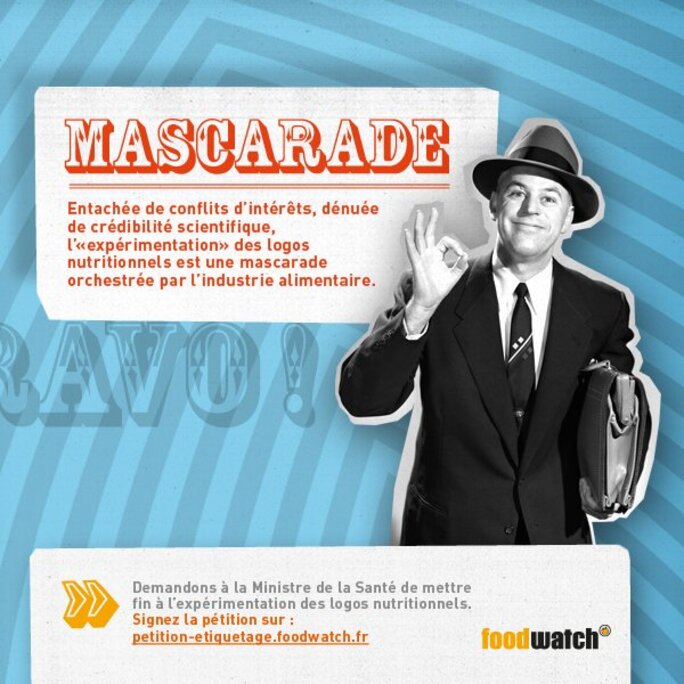For some it has descended into fiasco, for other critics it is quite simply a “farce”. A ten-week government-backed trial to test which labels should be used on food to inform French consumers about a product's nutritional value has met with fierce criticism. Some observers claim the study has been hijacked by large-scale food producers and should now be stopped altogether.
“The fact that [health minister] Marisol Touraine made use of the health law to put in place simplified nutritional labelling was good news,” says Chloé Stevenson from the food quality campaign group Foodwatch France. “But we were disappointed to see that the minister decided to embark on a trial that was asked for by the agro-industry, which incidentally has never wanted labelling.”

The ten-week trial began on September 26th, 2016, and aims to test the effectiveness of four different nutrition-based food labelling systems in French supermarkets. The live trial is being carried out in a total of 40 Carrefour Market, Simply, and Casino stores spread across the Paris region, the Hauts de France and Normandy regions in northern France and the Rhône Alpes region in south-east France. It involves four different types of produce: fresh deli meals; mass-produced pastry products such as brioches and croissants; different types of bread; and ready-made meals such as cassoulet and paella. In total more than 1,200 products are being labelled in the trial, split between the four different types of label being tested. The results are due in by the end of the year.
However, Foodwatch claims the entire trial is a “diversion” and that in fact the wide-ranging health law passed in December 2015 allows the minister herself to decree which labelling system to use, choosing between two approved options. The first of these, Nutri-Coleurs, is based on the so-called British 'Traffic Light' system, which uses three colours to grade the nutritional value of a product's ingredients. The second, called NutriScore, has a five-colour chart from green to red, indicating the nutritional quality of a product. This latter label is backed by France's health advisory body the Haut Conseil de la Santé Publique and more than 239,000 consumers have already signed a petition demanding its immediate application.

But following the direct intervention of agriculture minister Stéphane Le Foll, Marisol Touraine instead chose to open a “consultation” that included the agri-food industry and supermarkets. They were swiftly granted the go-ahead for a trial which includes their own nutrition label proposals, in addition to the other two labels. These industry-backed systems are SENS, which is backed by the food distribution federation the FCD and which recommends how often certain products need to be bought, and the Nutri-Repère system, a simple adaptation of the current label, which comes from the national association of food industries the ANIA.
Yet according to critics these two industry-backed systems are not on a par with the two options backed by many health experts. “There's a problem with these two logos which are not easy to understand and whose scientific basis is poor,” says Chloé Stevenson.
Foodwatch says that the trial itself has become a “farce”, having been dogged by “numerous problems” and that it suffers from irregularities which highlight its “lack of reliability”. These include a low participation of various product brands in the trial and unequal treatment given to the different labels, as well as shortcomings in two of the labels themselves.

Enlargement : Illustration 3

Critics fear that the fact that the trial has gone ahead and the way it is being conducted suggests collusion between the minister Marisol Touraine, her team and the food industry. To support their claims they point to the fact that she has given way to all manner of requests from industry, even the most improbable. The co-presidency of the trial's pilot committee was given to Christian Babusiaux, president of the food and health foundation the Fonds Français pour l’Alimentation et la Santé (FFAS), set up and funded by the food manufacturers' body the ANIA. Then, via her director general of health Benoît Vallet, Marisol Touraine agreed to hand oversight of the trial - without any tender process - to the FFAS. The ministry itself put up 1.2 million euros of the 2.2 million-euro cost.
Moreover, it was the FFAS who chose, also without any competitive tendering, communications firm LinkUp to run the trial itself. Critics say that LinkUp has been behind numerous campaigns of so-called 'greenwashing', the process by which an organization's products or policies are promoted to encourage the perception they are environmentally friendly. For example, the agency was behind the OpenLab Nutella campaign on behalf of Italian manufacturers Ferrero in order to “debate” the “reality of sustainable palm oil”. The agency also works for a number of other big producers and brands such as Lesieur, Mondelez, Nestlé, Bordeau Chesnel, Orangina, Quick and Charal.

Enlargement : Illustration 4

Foodwatch also points out that “six renowned experts” in epidemiology and nutrition have “walked out of the [trial's] scientific committee”, and that the director of the French National Institute of Health and Medical Research (INSERM) has left the pilot committee. One expert has argued that it is more like a “marketing operation” than a scientific evaluation. This type of test needs to allow for “analysis by an independent body or laboratory”, which was not what the scientists were able to obtain, said the expert.
Today, more than a month after it began, the implementation of the trial seems to have been beset by irregularities. Observations on the ground contradict the data advanced by the FFAS, according to researchers and dieticians from the Paris-based Nutritional Epidemiology Research Unit (UREN), who support the five-colour system and who were present between the second and third week of the trial.
At that time only 60% of the pastry products, 49% of the fresh deli meals and 25% of the pre-cooked meals were labelled. Across the whole range of brands in the sections that are being tested fewer than 40% had labels. But the irregularities also included unequal treatment between the labels that are being trialled. “A certain disparity in the level of labelling was found between the different systems being evaluated,” said the UREN experts. “In particular, in the two supermarkets visited where it is being tested NutriScore had on average been labelled in just 30% of cases, all sections and periods included.” According to these observations 59% of the products due to be branded with the Nutri-Repère label backed by the industry organisation ANIA had been labelled, against 52% of the Nutri-Couleurs label, 46% of the SENS label and 30% for NutriScore.

Enlargement : Illustration 5

Sandrine Ruffin from the LinkUp agency confirmed on the FFAS website that there were some initial issues with the labelling, saying that there had been a “setting up” problem for their teams in the first week but that since then the products had been “well-labelled” across the sections.
Meanwhile one of the members of the trial's scientific committee, Pierre Chandon, who is a professor at the INSEAD business school near Paris where he is the L'Oréal Chaired Professor of Marketing, Innovation and Creativity, says he is comfortable with the labelling flaws. “The great majority of products are labelled,” he explained on the FFAS site. “It goes from 67% to 87%. And that's a bonus because that's what's going to happen in real life. The manufacturers will have the choice whether to label their products or not. Not all products will be labelled. It's going to recreate what will happen afterwards. It would have been a mistake to label 100% of the products.” The professor of marketing says that the fact that not all products are labelled will provide information about consumer behaviour. However, in the trial's scientific protocol it was recommended that for the sake of statistical validity all products should be given a label.
Another independent group, Openfoodfacts, a non-profit making food products database, carried out checks on the trial in two stores. The volunteers noted that the calculations carried out by the FFAS and LinkUp did not always conform to NutriScore's results. Their testing tool is an app created using the formula and the algorithm of the five colours system. It has already been downloaded by tens of thousands of people and allows consumers to obtain the nutritional rating of around 30,000 of the 100,000 products they have on their database. “The five-colour system allows you to compare products,” says the man behind the app, Stéphane Gigandet. “It's the only one that a child can understand. Today children are very influenced by the little animals drawn on cereal packets. It's urgent that something radical is done as what's been done up to now isn't working. I hope the industry will realise that it's in their interest to fight for quality and not just on prices.”
In a statement Foodwatch also talked of the “urgent” need for a simplified nutrition labelling system. “The World Health Organisation is warning about the epidemic of chronic illnesses, the leading cause of mortality in the world,” it said. “Food contributes to the progression of such chronic illnesses as obesity and diabetes. In France [long-term illnesses] already affect 15% of the population – ten million people – and this rate is due to increase to 20% in 2025.”
Contacted by Mediapart neither the ministry's director general of health, Benoît Vallet, nor LinkUp's Sandrine Raffin wanted to comment.
---------------------------------------------------------------------------
- The French version of this article can be found here.
English version by Michael Streeter


